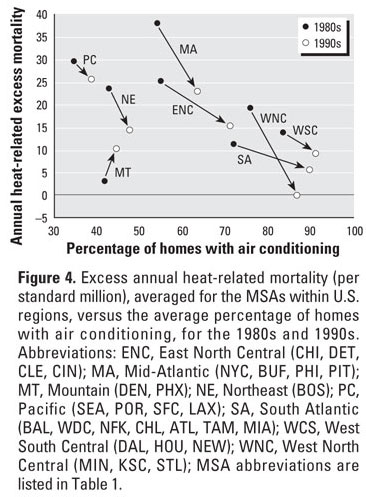
In 2002, Eric Klinenberg, author of the classic study of the 1995 Chicago heat wave (and Heat Wave really deserves to be on the short list of best non-fiction books about the city), asked an interesting question, "Why don’t Americans sweat over heat wave deaths?":
[H]eat waves kill more people in the United States than all of the other so-called natural disasters combined. More than 400 Americans die from heat-related illnesses in a typical year. Annual mortality from tornadoes, earthquakes, and floods together is under 200. Since heat waves inflict damage on the nation’s major cities, well within the range of most media organizations, the lack of visibility or panic is all the more mysterious.
Klinenberg says that the 1995 heat wave, in which 739 people are established to have died, stood by 2002 as a "non-event." I think that’s a bit of an exaggeration—though it might be more true had he not written his book—but broadly it’s a pretty good point.
One point that Klinenberg makes is that heat waves don’t have eye-catching visuals, the kind that sear themselves into your brain. And they don’t leave physical damage, the remnants of which linger after the disaster. Which is true enough, but in my anecdotal experience, heat waves themselves tend to be pretty well covered, at least in terms of raw attention being drawn to them before and during the heat. Instead, the subtle complexities of heat waves, I think, have a lot to do with why people, media, and governments don’t always respond well to them.
First, almost everywhere in America gets hot at some point during the summer. 100 degrees is unusually hot for Chicago, but it’s not unusually hot for America, and the city isn’t unusually humid, either. I grew up in southwestern Virginia, which tends to be more temperate than people expect of the South, but I spent a couple weeks one summer in Raleigh, North Carolina working and without a car—not a great city for that—and it seemed like every day was as bad as it is this week in Chicago.
But the fact that Chicago infrequently gets both hot and humid, with high sustained temperatures, has actually been cited as a reason the city is periodically at risk of substantial excess deaths from heat:
In the United States, there does not appear to be a single universal threshold temperature above which rates of heat-related morbidity and mortality rise sharply. Instead, tolerance of excess heat varies regionally according to the population and its preparedness for heat and according to the local average temperatures and frequency of extreme temperatures (23). In temperate regions, severe but infrequent temperature fluctuations, such as very hot episodes during periods of generally milder weather conditions, are associated with increases in weather-related mortality. In tropical regions, summer temperatures are higher for a longer period of time and are less variable. As a result, elevated temperatures in these regions do not appear to have a significant impact on weather-related mortality.
Models of the weather-mortality relationship indicate that populations in northeastern and midwestern U.S. cities may experience the greatest number of heat-related illnesses and deaths in response to changes in summer temperature, and that the most sensitive regions are those where extremely high temperatures occur infrequently or irregularly (24), including Philadelphia, Pennsylvania (25); New York, New York (11); Chicago, Illinois (4); Milwaukee, Wisconsin (13); and St. Louis, Missouri (17), where past heat waves resulted in large numbers of heat-related deaths. In some heat waves, daily mortality levels are more than double baseline levels (26).
In other words, it’s not just that it’s hot, or that it’s hot and humid. It’s also a matter of relative temperature. A heat index of, say, 110, likely means something much different, and more ominous, in Chicago and other norther cities than it does in more southern climes:
In general, cities along the southern tier of the United States, particularly in the Southeast, exhibited the weakest heat-mortality relationships. Most MSAs in the Northeast and Great Lakes regions have had mortality declines over time but still showed statistically significant mortality increases after high AT days in the 1990s.
That study did a "cursory" (their word) analysis that correlated air conditioning with mortality, and the results are what you would expect: hotter places have more air conditioning and lower mortality due to heat:

Second, the more you look at why certain types of people die during heat waves, the more complicated things get. Obviously, the most vulnerable demographic is the elderly—the human body is simply more fragile as it ages. But there are lots of specific reasons for that. The bodies of the elderly don’t self-regulate as well. The elderly are not only more likely to suffer from chronic diseases, but the medications for those diseases can, in some cases, make the body even less able to regulate its own temperature, or to signal to the brain that the body is at risk from heat. They’re less likely to be mobile, making it harder to go to cooler places.
And some of the variations can be mysterious. In France during the heat wave of 1993, women were disproportionately affected; in Chicago in 1995, men were disproportionately affected.
In the Chicago heat wave, Latinos were statistically underrepresented in excess deaths attributable to heat, which Klinenberg addressed in Heat Wave. As the Chicago Reporter‘s Micah Maidenberg puts it:
For all the challenges a working class, immigrant-heavy neighborhood like Little Village faced in 1995, it had not had to grapple with what Klinenberg calls the "particular constraints of ghettoization," as had black residents of Chicago. Those constraints left a frayed social fabric in poor black neighborhoods bearing the burden of "rapid and continuous abandonment of institutions and residents … arson and violence." A "local social ecology" that could have protected seniors–that did protect seniors elsewhere–was destroyed.
In other words, a heat wave affects different demographics in complex ways, interacting not just with the situations of individuals, but also with communities and their histories. It’s like the different effects of Katrina on New Orleans, only much, much more complex.
And temperatures can vary within cities due to differences in development, as a 2006 study of Phoenix (PDF) points out.
Third, we tend to look at the specifics of heat waves in ways that don’t directly correspond to their health threats. Take this piece from MSNBC, which is, as I write this, the main story on their home page. Only high—i.e. maximum—temperatures are mentioned. But maximum temperatures are only an element of what makes heat waves deadly. High minimum temperatures are considered a factor. High humidity is a factor, because it both raises minimum temperatures by trapping heat overnight, and because it raises body temperatures by trapping heat in the body. Length of the heat wave is considered a factor. As noted above, relative temperature is as well.
The heat index and humidex both factor in heat and humidity. And as Laurence Kalkstein, a climatologist with an academic interest in heat warning systems wrote back in 2004, our understanding of heat waves and their effects on people is growing more sophisticated, if not yet enough (PDF):
An “excessive heat warning” is often associated with a heat index of 115°F (46°C) or higher. In recent years, to account for local climatological conditions, a number of local offices have modified these thresholds downward, especially across much of the northern tier of the United States, which such conditions are rare, and heat-related mortality occurs in significant numbers well before such thresholds are exceeded. Though these modifications have increased heat awareness, they have generally been haphazard, with different rules set up by each office, with little spatial cohesion. Moreover, few of these modifications are based upon an actual human response.
Kalkstein has been working on a "heat stress index," which includes "previous weather conditions, the maximum and minimum temperatures in your area, cloud cover, cooling degree hours, and consecutive days of extreme heat." Here’s a heat index map; right now Chicago’s just on the brink of a 115-degree heat index measurement.
Update: A completely nonscientific theory:
People have an instinctual fear of random death. Opaque as heat wave mortality can be, it’s really not very random. If you’re young, healthy, work indoors, and don’t take unusual risks, the chances of dying from the heat are almost nil. Whereas most other natural disasters can take you if you’re just in the wrong place at the wrong time. Heat waves just don’t tap into that instinctually morbid fascination.
Photograph: Chicago Tribune


